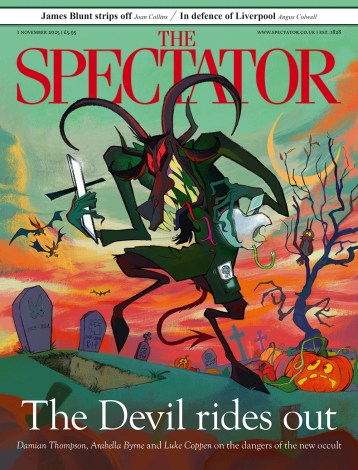The following novel re-assessment is typical of Andrew Lambirth:
Although Eileen Agar exhibited with Miro, Magritte and Ernst, she was never a ‘card-carrying surrealist’. The origins of her work were rooted in ‘the great English Romantic tradition’ — medieval illumination, William Blake, Edward Lear.
Lambirth approaches painters and paintings not through the prism of current fashion but in the light of his extensive knowledge and through looking, intently and without prejudice.
It is what makes his weekly judgments in The Spectator always refreshing and his writing unlike that of any other critic since David Sylvester. This collection of his interviews, exhibition reviews and ‘reflections’, taken from his Spectator pieces over the past 15 years, is full of such perceptions.
In them his love of drawing, of colour and of technique yield fresh views on such established artists as Lowry, Sutherland and Freud. They lead him to reassess artists who are, in his view, undervalued (John Hubbard, Laetitia Yapp) and to retrieve the reputations of others who are in danger of being forgotten (Cedric Morris, Roland Collins, Alan Reynolds, John Armstrong).
He continually surprises: what other critic is interested in painters who work with writers (Wyndham Lewis with Naomi Mitchison; John Craxton illustrating Geoffrey Grigson’s anthology, The Poet’s Eye; more recently the Royal Academy’s pairing of Norman Ackroyd with Douglas Dunn)? Who else so consistently champions landscape?
In our secular age he is not afraid of spirituality as seen in our great cathedrals, praising Craigie Aitchison’s work in Truro, Christopher Le Brun’s and Elizabeth Frink’s in Liverpool and Antony Gormley’s figure in prayer in Westminster cathedral. He deplores ‘dogma and quick-fix skills’ and has little time for ‘watered-down conceptual art’.
He admires painters who engage in a dialogue between Englishness and modernism, citing Keith Coventry, Euan Uglow and Prunella Clough, and quotes with approval Maggie Hambling’s view that ‘drawing is very exciting, the most intimate thing’ and her perception that ‘a photograph has happened, it’s history, it’s gone. If a drawing has any life to it, it hasn’t happened, it is happening in front of you as you look at it.’
You might fear that in the limited space available to him his pieces could become journalistic tapas, excellent but ultimately unsatisfying. Not so. They are crammed with nice judgments: Leon Underwood, who taught Henry Moore, is ‘desperately neglected these days’; Bryan Kneale (‘better known as a sculptor’) is applauded for a ‘tough portrait of Herbert Read’, Orpen is ‘a master of the combined pencil and watercolour study … his control of charcoal is exquisite.’
And he can write beautifully: El Greco’s ‘flickering attenuated figures writhe upwards like candle flames’, while Patrick Heron, in a photograph, is ‘poised like a dancer in mid-conversation, marking time with a pencil’.
This is a superb anthology of what is best in contemporary painting, the most comprehensive overview since Rothenstein’s two-volume Modern British Painters in the 1950s. Lambirth takes the trouble to travel round Britain, to small galleries and to artists’ studios, in a way that few other writers on art do. So that it is not at all surprising that he is a contributor to a new book on British Murals and Decorative Painting, a subject that hasn’t engaged the attention of many others.
This book, edited by Paul Liss, considers why murals are rare these days, given this county’s great tradition: Rubens’s ceiling panels in Inigo Jones’s Whitehall Banqueting House, Sir James Thornhill’s work in St Paul’s and Greenwich, the Royal Fine Arts’ commissioning of Daniel Maclise and others in the Houses of Parliament and, in the 20th century, Stanley Spencer’s Sandham Memorial Chapel and Rex Whistler’s work at Plas Newydd and in the restaurant of Tate Britain.
The 20th century started so promisingly with William Rothenstein and Henry Tonks, at the Royal College and the Slade, promoting murals. Tonks’s pupils included Stanley Spencer, Thomas Monnington (considered here by both Liss and Sam Smiles) and Mary Adshead, who went on painting into the 1980s. Edward Bawden and John Piper flourished. But the destruction of buildings in the second world war, and changes in architecture, have led to a decline in mural painting.
In this book Andrew Lambirth writes on John Armstrong and, in his Spectator pieces, on Charles Mahoney whose mural cycle for the Lady Chapel at Campion Hall in Oxford is, in his view, ‘another well kept secret’. But neither he nor Liss predict a revival of the skills required for murals.
Both books brim with Lambirth’s love of painting and his belief in its importance. He quotes William Hazlitt: ‘Pictures are scattered like stray gifts through the world; and while they remain, earth has yet a little gilding.’ Readers of this magazine are fortunate to have him weekly as our guide to find those pictures and that gilding.






Comments